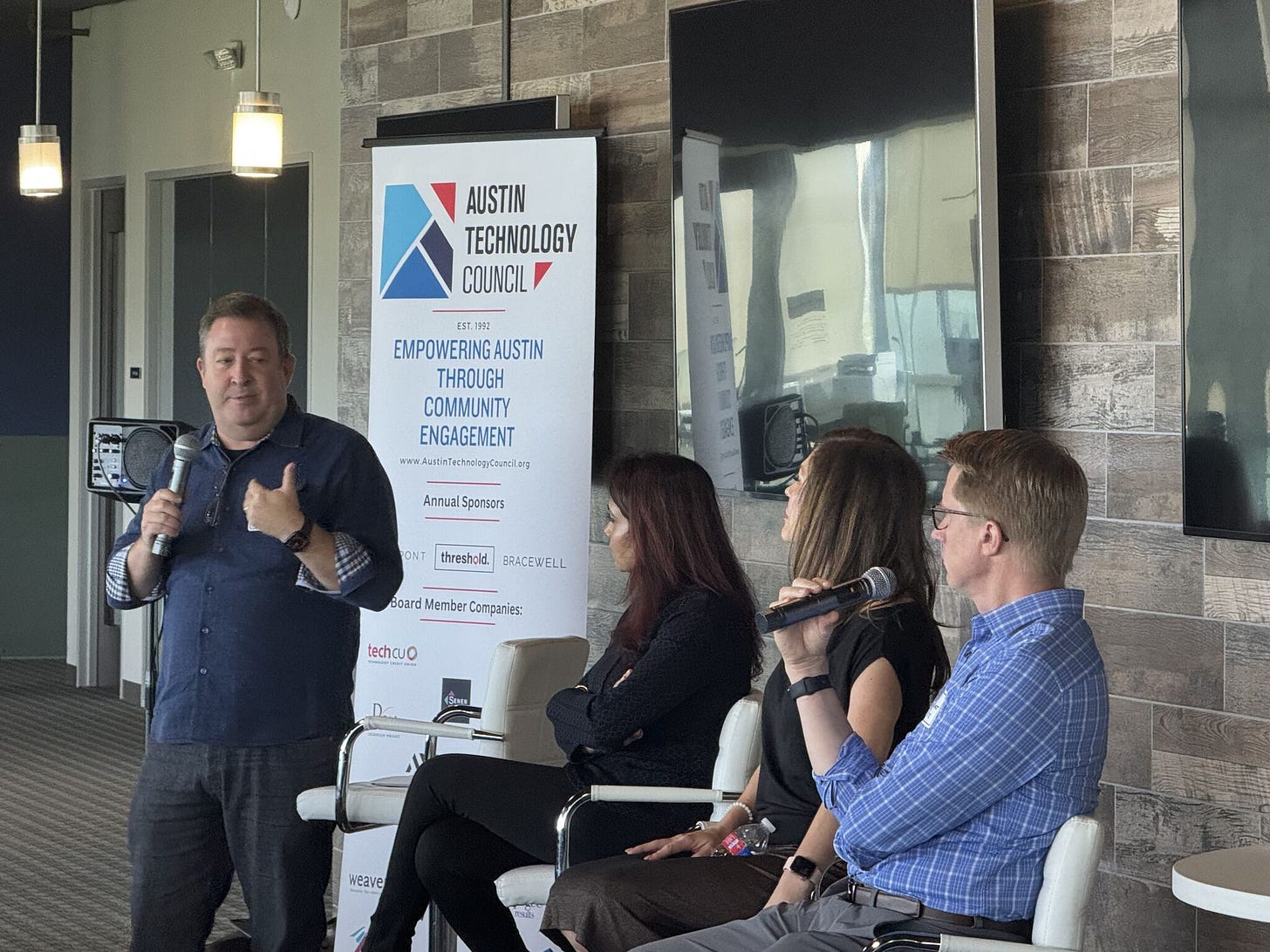The Question: How to Scale?
ATC Roundtable Breakfast reveals the opportunities and challenges of scaling your business from Austin
Thom Singer has been leading a renaissance at Austin Technology Council (ATC). One of the surprises is how the breakfast roundtables have evolved into must-see content and networking - even in the heat of summer! Seemingly every month, ATC finds a key issue that drives attendance and interest. Calavista’s offices offer a vista of the Austin hill country and a space for networking/discussion that is much appreciated.
Meanwhile, post-BP3, I’ve been working on my own renaissance — working to establish an advisory/board practice. I want to leverage my experience — with private equity, international expansion to Europe, offshoring and outsourcing, and technical services — to help other companies grow and thrive. I feel that it is time to pay it forward. Those threads came together last week at ATC.
Our Panelists
Last week, we gathered for a panel on Strategies for Growing your company - and the challenges of scale. We started with quick introductions and what phase each of these scaling companies is in. On the panel:
Linda Ginac, CEO and founder of TalentGuard, has raised venture capital and in growth mode
Bjorn Billhardt, CEO and founder of Abilitie, bootstrapped, also growing!
Bonnie Sheth, CEO and founder of Senen Group , bootstrapped, growing organically
and myself (Scott Francis) as the moderator, having founded and led BP3 for 17 years. BP3 is in scale mode as a services company in the US and Europe, and is now Private Equity backed.
How do you know it is time to Scale?
I started by asking how did you know it was *time* to focus on scaling your business? That scaling now was actually a good idea? The answers were interesting. In 3 cases the signals were external in nature (or the turning points were external):
at BP3, we were partnered with Lombardi Software. We had 5-7 employees. When IBM announced they were buying Lombardi, we knew we were entering growth mode and we leaned into hiring. Just a few years later we had north of 100 employees.
at Abilitie, COVID was the externality that changed everything - as they realized their own offerings translated really well virtually, while the traditional business education (business school) formats did not!
at Senen Group, also Covid put an emphasis on their ability to partner and work virtually all over the world, and signaled a renewed focus by companies on their data and AI stack.
at TalentGuard, it was the internal metrics that were all pointing to growth - basically, their internal systems to track and measure their business were going “green” and it was time to build the case to raise money and hit the gas.
The take away I took from this is that none of us could precisely predict either the timing or the nature of these external events, but what each of us had in our favor was that we had healthy businesses that were *ready* to grow when circumstances allowed for it.
The luck - the externality - isn’t the thing. It’s being ready to make the most of it when you do get some good fortune or wind at your back. And that is why you have the saying that you “make your own luck”. Had these events happened - and caught each of us unprepared - then we would not be talking about how we successfully scaled — we’d be talking about how we missed a great opportunity.
What Breaks?
We also explored what breaks as you start scaling. The focus here was on team members. Figuring out which team members have a growth mindset and can grow into expanded responsibilities, and those that aren’t adapting and leveling up. At BP3, as one example - our account management outcomes improved dramatically when we hired Rainer Ribback - and this helped us grow the business tremendously over the next 3 years. Each of us could point to examples were a new hire unlocked a new phase of growth.
The tough part for any scaling business is when you have to bring in new talent from outside, to take on roles that talent inside the building hoped to be doing (or are already doing, but not well). It’s also tough to say goodbye to someone who has done valuable work for you in the past, but isn’t able to scale to the next role required.
While the “easy” ways out include:
creating paths for promotion/excellence that aren’t “management” roles, so that great individual contributors can stay and continue to excel (and acknowledging that some great contributors are simply not good managers or leaders of organizations);
bringing in support for them as a manager (a strong lieutenant, or training programs and leadership development), or bringing in a manager/mentor who will eventually transition back to that internal member of the team;
Offering a different role with responsibilities better suited to them;
Often, a growing business cannot afford to implement these answers. Often these businesses have to make hard choices - they don’t have the budgetary room to pay for two people to do a job that one person can do. They may not have the funds (or time) to wait for mentorship or training and development programs to pay dividends. And a different role may not provide the compensation and job satisfaction that your long-time employee requires to stay and be happy about it.
When parting ways, we discussed how important it is to be as supportive as you can be. Celebrating those who leave on their own terms, as well as people you encouraged to take on their next adventures.
One theme that became clear across the four of us is how much we care about our teams and how grappling with these decisions just isn’t easy for anyone.
Can you Scale Internationally from Austin?
We also turned to the topic of international expansion. Here were 4 businesses represented, all headquartered in Austin, Texas, and all with international expansion plays underway. Ronnie emphasized partnerships around the world, and the fact that Senen Group started in Canada and then Austin, so they had broken the seal on international very early on. Bjorn’s company Abilitie had international customers before they had international presence - leading to a lot of international travel in the early days. TalentGuard is also expanding internationally, starting with Ireland. BP3 expanded internationally through acquisitions into Europe and South Africa. Each of our business necessitated different styles of expansion to these geographies, which I find fascinating.
One of the topics that came up was getting help from groups like IDA Ireland. It turns out if you are expanding to a new city or country, there are organizations that are designed to roll out the red carpet for you (think, organizations like Opportunity Austin here at home). They will do this more for a business entering their markets than they will for businesses that are home grown! Our take was to take advantage of these partnership opportunities and learn about government incentives that may help you defray the up front cost of expanding into new regions, and they’ll introduce you to legal representation and payroll services and HR help.
We also talked about the cultural challenges to international expansion. They were particularly curious about this for me as we’ve done business in so many places and via M&A. First, on performance culture — I think the concern Americans often have is whether you can expect high performance culture in a country that has work rules that prevent companies from terminating employment easily. I relayed my experience, that other than one or two specific instances, we’ve had great performance and work ethic from our European team members (and team members everywhere). That as with all things, the most important point is that the individual buys into *your* corporate culture. With M&A it is important that the companies you acquire have leadership teams that focus on high performance culture and how to attain that in their geography.
We also talked about the more human side - holidays, differences in language, and differences in ethnicity, and even differences in how they look at international conflict such as Russia’s invasion of Ukraine or the violence in Gaza and Israel. These issues hit differently when you have team members who identity with both sides of any given conflict.
All said, I think each of us is grateful for the experience that running an international business has offered us. I know for my part, I have evolved so much as a person and a business leader for these experiences. It is an opportunity of a lifetime to develop lifelong friends in faraway countries.
After our talk, I met an entrepreneur from Germany who is expanding to North America - with Austin as their North American headquarters. I think it’s a great decision for serving the North American market.
The Impact of AI on Scaling
Finally, we discussed the impact of AI on our businesses and the idea of scaling our business. On this point, each of us had examples where AI yielded higher productivity or lowered costs. Bjorn pointed out that a significant percentage of the code his team writes is written with the aid of AI agents. They represent a tool that makes software developers super-charged in productivity.
Linda’s team is focused on finding what they can automate with AI - a key distinction in my mind is that mostly AI is about automation, and the techniques open up whole new avenues for automation that were previously closed.
AI is already changing the way we do customer support and offer access to tutorials and documentation.
Ronnie encourages us to think about new capabilities we can offer to our team and to our clients with AI - not just doing the same things faster, but offering net-new capabilities - incredibly important point.
AI is going to change our business models and accelerate some businesses while undermining others. Opportunities abound.
Other Topics:
There are a few topics we didn’t engage in - that could be a future breakfast roundtable on their own:
How do you think about raising money - whether VC, PE, Growth Equity (still PE!), or Private Lending. How does that impact your growth and your decisions running a company?
Does M&A factor into your future growth plans?
What secrets can you share about how to scale Sales and Marketing?
What secrets can you share about how you scale your delivery capacity when Sales and Marketing are running ahead of it?
How do each of us make time for the important non-profit work we do? This panel is proof that you can, and should, do both. Build your business, and build your community.
I’m really thankful for the team on stage. We can conclude that Austin is a great home base for scaling a business - even an International one! The three panelists joining me on stage are great people to learn from as well. I’m looking for businesses I can help grow. If I can help in your journey to scale your business, buy me coffee and let’s talk about it!
One more thing… Austin reaching Skyward
Ryan Puzycki has been writing “City of Yes” from his Austin perch, and I love his blog. The latest installment is a good example: The Last Skyscraper. The article takes on the Austin skyline - with the last sky scraper still under construction - the Waterline, now topping out. A year ago, half a dozen buildings were nearing completion, now only one is still being built (the other wall completed in the last year). It’s a key turning point in the evolution of Austin’s skyline.


A key quote (emphasis added):
They’re also strange things. Skyscrapers emerge from bedrock on the most rational of financial projections—and yet are often driven toward the clouds by some of the most starry-eyed dreams. Architect Cass Gilbert, who designed the Woolworth Building, once said that the purpose of a tall building is “to make the land pay.” But skyscrapers are more than economic machines—they’re symbols of hope.
Later in the same post, we circle back to this point:
Because skyscrapers are not merely buildings, they are living monuments that reflect the optimism for the future in the era in which they were built. They aren’t just barometers of how much the land will pay—they’re beacons of belief, paying it forward. As Bascomb described the last skyscrapers of the Roaring Twenties: “All the exuberance, daring, romance, moxie, innovation, and pride that infused the decade is seen in these pinnacles.” They “reflected the spirit of a country in the making.” Would that our own age, for all its innovation and pride, have something of the romance of the last Roaring Twenties.
I agree with Skyscrapers being aligned with hope more than I can put into words. But, in a comment on Ryan’s post, I tried:
I moved here in '94, and let's just say that the skyline is quite transformed since then. More than once, I thought the building boom was over (and so did many others).... in 2001/2. again in 2008/9. And even as Covid entered our lexicon. and each time, I was wrong.
This time we have another pause- but who can tell what happens next!
I'll share a brief thought as well about hope, and what a skyscraper can stand for. After 9/11, like many people, I found myself laid off from my first job out of college, one that I had worked hard at for 7 years, a place where I had a lot of respect, to which I tied much of my identity and value to. I loved that work, and the people I worked with.
(moving on from this was hard, but good work to do on improving myself)
As I started looking for work, Dice dot com was offering work for software engineers for $15/hour. My plumber charged $75/hour. It felt like it might be the end of software engineering and consulting as a gainful employment /profession, especially with companies so focused on moving jobs offshore, and the dot-com bust delivering so many bad financial returns to investors and companies. Many of my friends (indeed, most of my closest friends) moved away from Austin during that time, to try to reinvent themselves in San Francisco, Boston, New York, or LA.
During that time on the bench, I played a lot of ultimate frisbee over at Martin Middle School's fields on the weekends. (public park right next to the school). And from there, I had a good view of the Frost Tower going up. And I felt like it was a symbol that someone still believed in Austin. (And indeed, interviews with the folks who ran that project at the time indicated they did believe in Austin and they moved forward despite the headlines and they wanted Frost Tower to be a symbol of hope for Austinites with a memorable profile and crown as well). By the time Frost Tower opened I believe it was 85 or 95% leased. I found a contract to keep me fed in 2022, and a job in the summer of '23 that allowed me to afford an engagement ring for my wife, and a wedding. And that job (at Lombardi Software) led to the founding of BP3, which was the company that the building of defined the next 17 years of my professional life, and made possible so many things in my personal life.
Frost Tower was and is really important to me for that reason. And the idea that some people will power through - not just with hope, but by proving doubters wrong, and forging a new reality.
In a very real way, Ultimate Frisbee in that era was my meditation, and Frost Tower was the point on the compass. Now, I can’t even see Frost tower from most places in Austin - because the rest of the cityscape has grown up so much. Austin has been good to me. I am grateful. And I have hope for the future of Austin and of each of us. I can tell you that Austin Technology Council is founded on optimism.
In case anyone was worried, there’s a lot of development still happening in Austin. In fact, in the Austin Business Journal on the day I wrote this was this article, detailing the projects approved at City Hall in the last meeting.




Thanks for the highlight, Scott! Great photos, by the way.